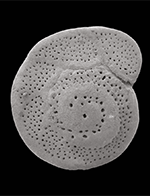 Foraminifera are single celled protists many of which precipitate a shell made of calcium carbonate, however some make their test from the organic material tectin, by agglutinating sediment particles or have no test at all. Shells are typically less than 1 mm in size (equivalent to a grain of sand) but some species can reach 20 cm. Despite their generally diminutive size, foraminifera are key players in global carbon cycling and climate regulation, and are reef and rock-builders in the marine realm. Some of the marine deposits that they form are perhaps best known for being the dominant component used in the Pyramids of Giza, Egypt. They are known from the Cambrian (~500 million years ago) to the present day and are a powerful tool for determining the age of sediments and palaeonvrionmental reconstructions in industry and academia.
Foraminifera are single celled protists many of which precipitate a shell made of calcium carbonate, however some make their test from the organic material tectin, by agglutinating sediment particles or have no test at all. Shells are typically less than 1 mm in size (equivalent to a grain of sand) but some species can reach 20 cm. Despite their generally diminutive size, foraminifera are key players in global carbon cycling and climate regulation, and are reef and rock-builders in the marine realm. Some of the marine deposits that they form are perhaps best known for being the dominant component used in the Pyramids of Giza, Egypt. They are known from the Cambrian (~500 million years ago) to the present day and are a powerful tool for determining the age of sediments and palaeonvrionmental reconstructions in industry and academia.
This module introduces the biology, ecology and stratigraphic utility of the different types of foraminifera (planktic, smaller and larger benthics). You will gain an understanding of the major phylogenetic & ecological changes in Phanerozoic foraminiferal lineages, as well as their wider application to detailed reconstructions of local and global environmental change (utilizing faunal and geochemical proxies), and minor applications in forensic geology, archaeology etc.
You will also work with the Lapworth Museum of Geology to understand why microfossil collections are important and best practices for their maintenance etc., as well as how to best to share these collections with industrial, academic and/or public audiences. This module is co-taught by academic and industry colleagues.